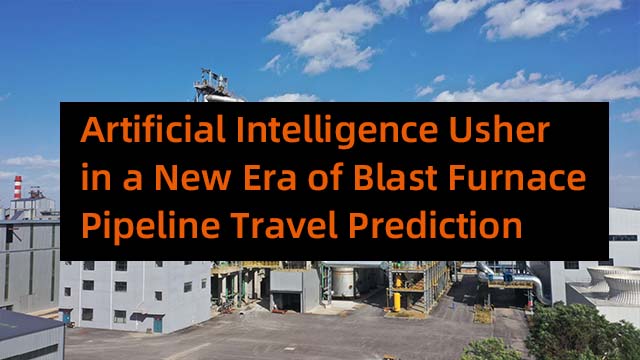Artificial Intelligence Usher in a New Era of Blast Furnace Pipeline Travel Prediction
2025-06-24 10:59:44 hits:0

In the production chain of the steel industry, the blast furnace, as the core production equipment, its operation status is directly related to the quality and output of steel products. As mentioned in *Tips for Stable Operation of Blast Furnaces*, the stable and smooth operation of blast furnaces is of great significance to the economic benefits of enterprises. Moreover, the quality of hot metal is closely linked to the operation dynamics of blast furnaces. Therefore, the precise control of blast furnace operation status is the key to ensuring the efficient and safe operation of blast furnaces. Among the many factors affecting the stable operation of blast furnaces, the problem of blast furnace pipeline travel has always been a persistent headache for steel enterprises.
Blast furnace pipeline travel refers to the phenomenon of uneven gas flow through the burden. Under normal circumstances, the gas flow in the blast furnace should be evenly distributed to ensure that the burden can be fully heated and reduced. However, when pipeline travel occurs, the gas flow rate in local areas will increase sharply, while it is relatively weak in other areas. This uneven gas flow distribution seriously disrupts the normal progress of heat transfer and reduction reactions, leading to a decline in blast furnace productivity, local overheating, and a substantial increase in coke consumption. *Steel Technology: The Practice of Henan Huaxi Technology in the Rapid Restoration of Wet Spraying for No. 8 Blast Furnace of Shougang Changzhi Steel* points out that in blast furnace operation, if the control of air volume and pressure during the burden lowering process is unreasonable, it is extremely easy to cause pipeline travel, affecting the stable operation of the blast furnace.
Upon in - depth exploration of the causes of pipeline travel, the complexity of blast furnace burden itself is the root cause. The uneven size, shape, density, and distribution of the burden result in uneven air permeability across the entire burden cross - section. The pipeline gas flow bypasses the dense areas rich in powder, thereby disrupting the preheating and reduction processes, leading to unstable production and reduced blast furnace productivity. Traditional methods for predicting pipeline travel mostly rely on indirect indicators such as gas flow, pressure changes, and temperature changes. However, these methods often have poor accuracy and limited early warning capabilities, which are not conducive to timely intervention and cannot meet the requirements of modern steel production for high efficiency and stability. *The Research Status and Development Trends of Blast Furnace Smelting Expert Systems* mentions that since the 1970s, many mathematical models have been developed to reduce the coke ratio of blast furnaces, but there are still deficiencies in the prediction of pipeline travel. Therefore, the search for a more reliable and proactive prediction method is extremely urgent.
A brand - new technology developed by a German company has brought hope for solving this problem. This technology uses advanced data analysis and machine learning methods to accurately predict the dynamics of blast furnace pipeline travel. Its working principle is to input real - time data from sensors such as pressure gauges, temperature probes, and gas analyzers into a pre - trained machine learning model. Through learning from a large amount of historical data, the model can identify patterns and anomalies related to potential pipeline travel accidents and generate a prediction score to show the probability of pipeline travel anomalies occurring within a specific time frame.
The specific process of this technology consists of several rigorous steps. First is data preprocessing, where the collected data is strictly processed to clean up outliers or inconsistencies and normalize it according to standard formats to ensure data integrity and reliability. Then, through feature engineering, more information is mined from the data based on the basic principles of blast furnace operation, and new features are designed to enhance the prediction ability of the model. Subsequently, various algorithms are evaluated, and a tree - based algorithm is selected, and the engineered features are trained using carefully sorted datasets. After training, the reserved test set is used to evaluate the performance of the model, and the precision and recall are analyzed in depth to ensure that it can be well applied to new data. Finally, the model is deployed in the production environment, running in real - time, continuously monitoring blast furnace data, and promptly notifying operators once anomalies are detected. This proactive approach enables rapid intervention and minimizes the impact of pipeline travel on blast furnace efficiency and production.
In evaluating the potential of pipeline travel, key process indicators (KPIs) play a crucial role. The CO/CO2 ratio can reflect the combustion efficiency. A too - low ratio indicates incomplete combustion during pipeline travel, while a too - high ratio implies excessive coke combustion, which may lead to unstable furnace conditions. The top gas temperature is related to the heat distribution and is an early warning signal for pipeline travel. The differential pressure is used to measure the pressure difference between furnace zones. A lower - than - expected differential pressure indicates that air bypasses the burden, and when the gas passage is blocked, a severe pipeline travel anomaly will increase the differential pressure. The blast volume may increase initially during pipeline travel due to lower burden resistance, but over time, the presence of gas passages will disrupt the flow direction and distribution, resulting in a decrease or fluctuation in the overall blast volume. By monitoring and analyzing these key indicators, this technology can more accurately detect the condition of blast furnace pipeline travel.
This technology adopts a first - principle - based modeling method, integrating the basic principles of blast furnace operation and focusing on key parameters such as hot blast pressure and temperature in different furnace zones. The pressure - temperature index developed in feature engineering can capture the interaction between pressure and thermal expansion, more clearly revealing the characteristics of the burden. This index is the basis for deriving the "permeability index", which can quantify the ease of gas flow through the burden. Specific ensemble algorithms such as random forest and gradient boosting are good at capturing complex nonlinear relationships in blast furnace data. Trained on historical data with time annotations, the model can predict pipeline travel events based on the current and past behavior of the blast furnace, helping operators take proactive measures before pipeline travel seriously affects performance, and displaying the threat level as "low", "medium", or "high" in the form of an odometer. Compared with existing pipeline travel prediction methods, this artificial intelligence technology has significant advantages. It can achieve early and accurate prediction, providing sufficient time for timely preventive measures and avoiding major losses. For example, in some practical application cases, this technology predicted pipeline travel anomalies several hours in advance, allowing enterprises to adjust operations in advance and avoid possible production interruptions. It can also be seamlessly integrated into existing control systems, enabling operators to grasp the blast furnace operation status in real - time. Its powerful data integration and management capabilities ensure the accuracy and consistency of data, laying a foundation for accurate prediction. Through continuous algorithm development and improvement, it can continuously enhance prediction accuracy and adapt to changing production conditions. The intuitive human - machine interface helps operators effectively interpret prediction results and take appropriate actions. In the future, if industry - wide standards can be established and adopted by different factories, it will have a broader positive impact. If this technology is successfully implemented, it will have a significant impact on the ironmaking process, achieving multiple benefits such as early detection, improved efficiency, enhanced accuracy, cost reduction, reduced production losses, and enhanced safety.
Of course, this technology also faces some challenges in practical applications. The accuracy of prediction depends heavily on the quality and availability of real - time data provided by blast furnace sensors, so continuous monitoring and maintenance of sensors are required. The seamless integration with existing systems is also the key to the efficient use of this technology, which requires a lot of work in technical docking and system compatibility. The accident caused by equipment problems in *The Cause of the Blast Furnace Fire of Baosteel on Weiyi Road Has Been Ascertained: The Pipeline Burst and Erupted Fire Due to the Fall of Refractories* also reflects from the side the importance of equipment maintenance and system stability for blast furnace production.
Looking to the future, with the continuous development and improvement of artificial intelligence technology and its deep integration with steel production processes, the technology for predicting blast furnace pipeline travel is expected to achieve greater breakthroughs. The MEAI full 3D visual online auxiliary analysis system for blast furnace smelting process mentioned in *Breaking through the "Black Box" of Blast Furnace Smelting and Optimizing Ironmaking Costs* deeply integrates the mechanism of blast furnace smelting process with artificial intelligence technology to achieve visual dynamic tracking of the full 3D blast furnace smelting process and provide quantitative basis for blast furnace operation. Similarly, the future technology for predicting blast furnace pipeline travel will also continue to innovate. It will not only bring significant economic benefits and production efficiency improvements to steel enterprises but also promote the entire steel industry towards the direction of intelligence and greenness, injecting new impetus into the sustainable development of the steel industry.

 en
en  fra
fra  de
de  ru
ru  ara
ara  gle
gle  it
it  jp
jp  kor
kor  th
th  zh
zh 


